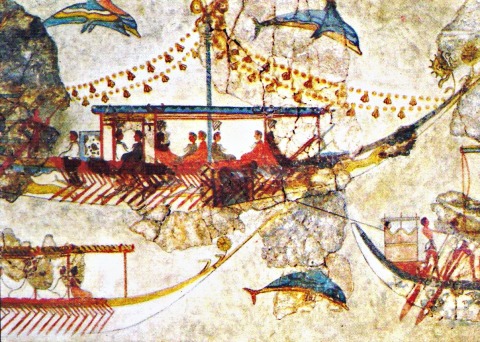
In Ariadne’s Tribe, as in many other Pagan traditions, we make offerings to the gods. This is a practice that connects us back through time with the Minoans and other ancient people. Offerings are a way to show our appreciation and thanks for the divine in our lives, a way to show our devotion. Most of the time, we make offerings to specific deities, though it’s also possible to set out items on your altar to the divine in general, the entire Minoan family of deities, or nature or Mother Earth.
Sometimes it’s as simple as a flower laid on the altar or a stick of incense lit with a silent “thank you.” Sometimes the offering is a ritual in itself, perhaps a libation of wine poured into a bowl or outdoors onto the ground. Often, offerings involve food or drink, just as they did in ancient times. But that leaves us with a question: What should we do with the leftovers when it’s time to clean off the altar?
Obviously, if you’ve poured some wine or milk onto the ground outside, there’s nothing left to clean up afterwards. That stick of incense? Just sweep up the ash and you’re done. Wilted flowers can go in the compost pile.
But what about leftover food? It seems a shame to waste food, especially in our bloated, “affluenza”-ridden modern world where we already waste so much of so many things.
Let me emphasize that we don’t honestly know what the Minoans did with the remains of offerings that had been set out in shrines and on altars, in other words, given to the gods. So we have to decide for ourselves what we’re comfortable doing in our own spiritual practice. There are a few options here.
One is simply to consider that the offering has been “served” to the god or goddess in much the same way you’d serve food to an honored guest who comes to your house for dinner. You wouldn’t take food off their plate and eat it yourself, would you?
In this case, you would leave the offering on the altar for however long feels right to you: overnight, a set number of days, until the next full moon, or some other span of time. Then you’d dispose of it in a respectful way, doing your best to honor the Earth and the resources that went into making that food. I garden so most of my food offerings end up in my compost pile: They go back to the Earth to make more food. I prefer not to set food outside for the wildlife to consume, simply because many human foods are harmful to wild animals. If I lived in the middle of a big city and didn’t have, say, a worm composter on my apartment balcony, I’d probably just put the remains in the trash.
But what if your offering is something much bigger? What if you’ve dedicated a whole meal to the Ancestors or Ariadne or Dionysus? To me, that’s kind of like having a dinner in honor of a special guest: You serve them their portion of the food and you (and everyone else who’s there) gets to eat the rest. In this case, I would dispose of the remains of their portion in one of the ways I listed above. This scenario is similar to the feasts in honor of the gods that many ancient cultures held. Often, the deity was assigned a specific portion of the main dish, which might have been an animal that was slaughtered in a sacred or ritual manner. The Minoans appear to have built special dining shrines just for this type of occasion.
There’s a third option for disposing of offerings, one that was common in ancient Egypt and that I’m sure the Minoans knew about: reversion of offerings. The process is simple: You set out the food and/or drink offering, give the gods some time to absorb the essence of it (they’re not physical beings so they’re not going to eat the physical food, right?). Then you remove the food from the altar and eat/drink it yourself so there’s no waste.
In ancient Egypt, there was a specific set of rituals for ensuring that the gods were satisfied before removing the offerings from the altar. It’s a good idea to do something like that, say a few words and really listen to make sure it’s OK to remove the offering before you do so.
There is, of course, a practical consideration for reversion of offerings as well. You don’t want to leave the food out long enough for it to spoil. Fresh fruit will last for days and still be safe to eat, and a loaf of bread might last a while as well, but you certainly don’t want to leave meat or most cooked foods out more than an hour or two, for safety.
In Ariadne’s Tribe, we don’t practice reversion of offerings as part of our tradition. We’ve found that the Minoan deities are not comfortable with this practice when we do it. But people who follow other traditions may choose to experiment with it, listening always to the deities along the way.
Regardless of how you dispose of your offerings, I hope you make plenty of them. It’s frequent interaction that keeps our relationships with the deities alive. And that’s a good thing.



